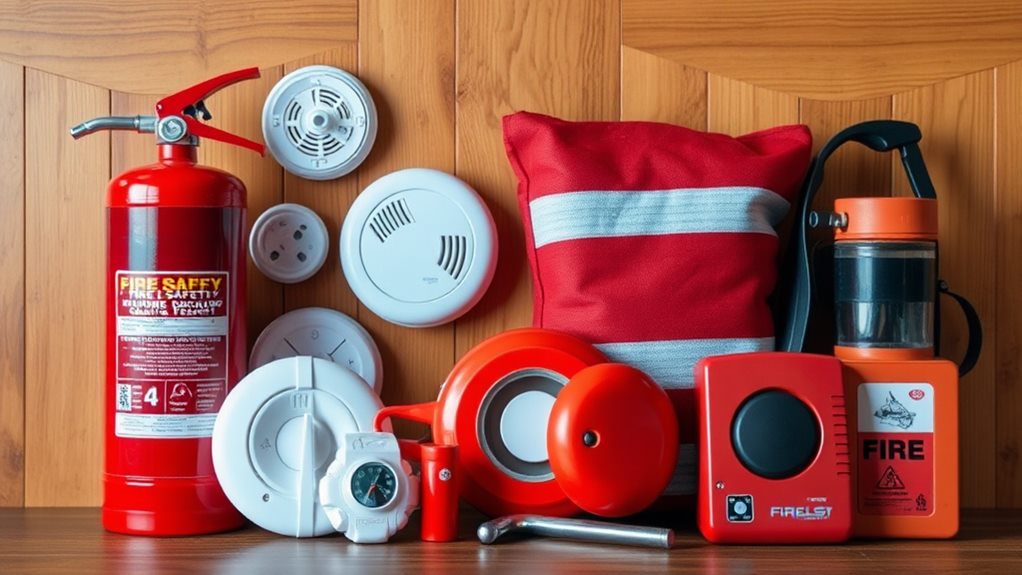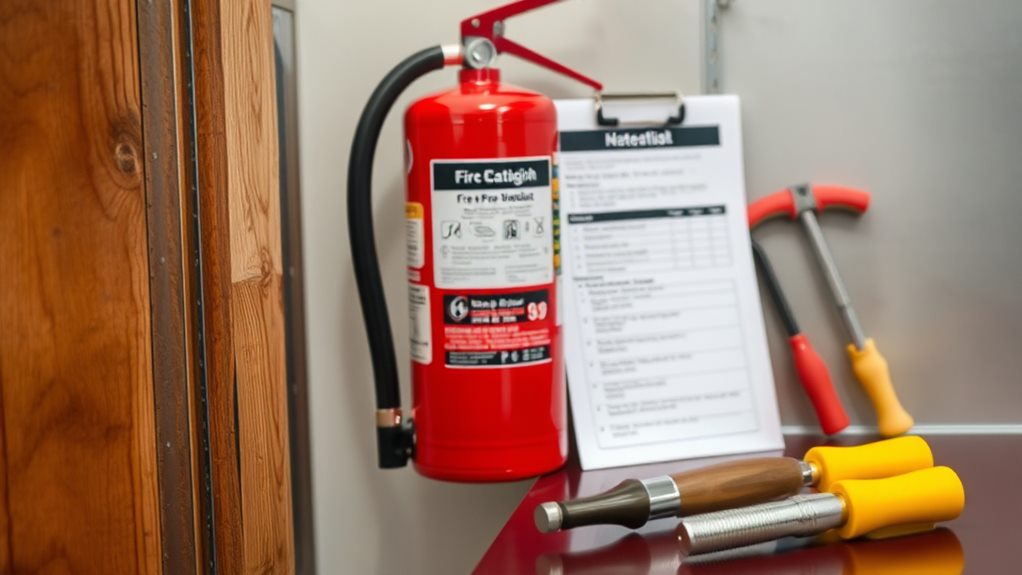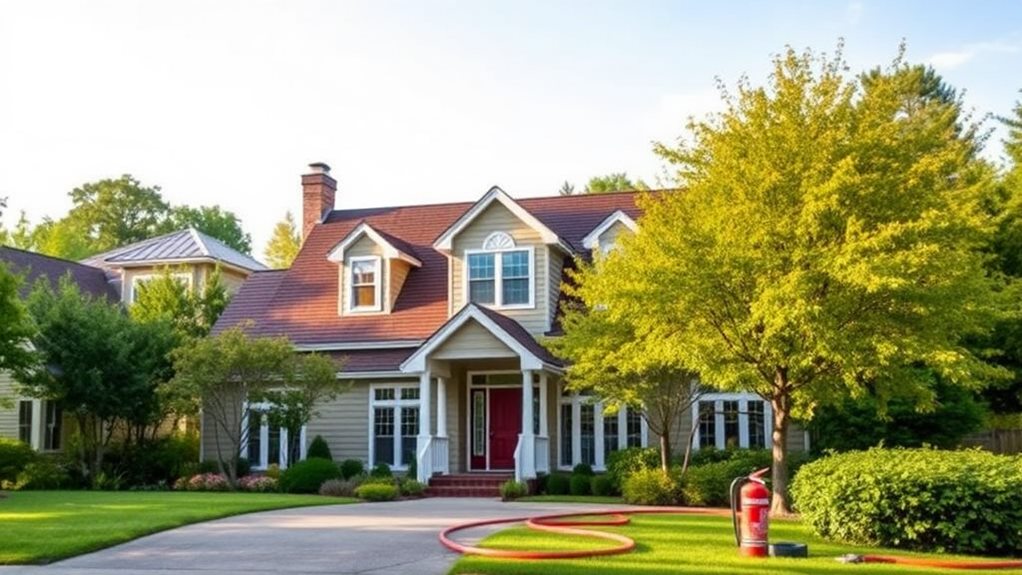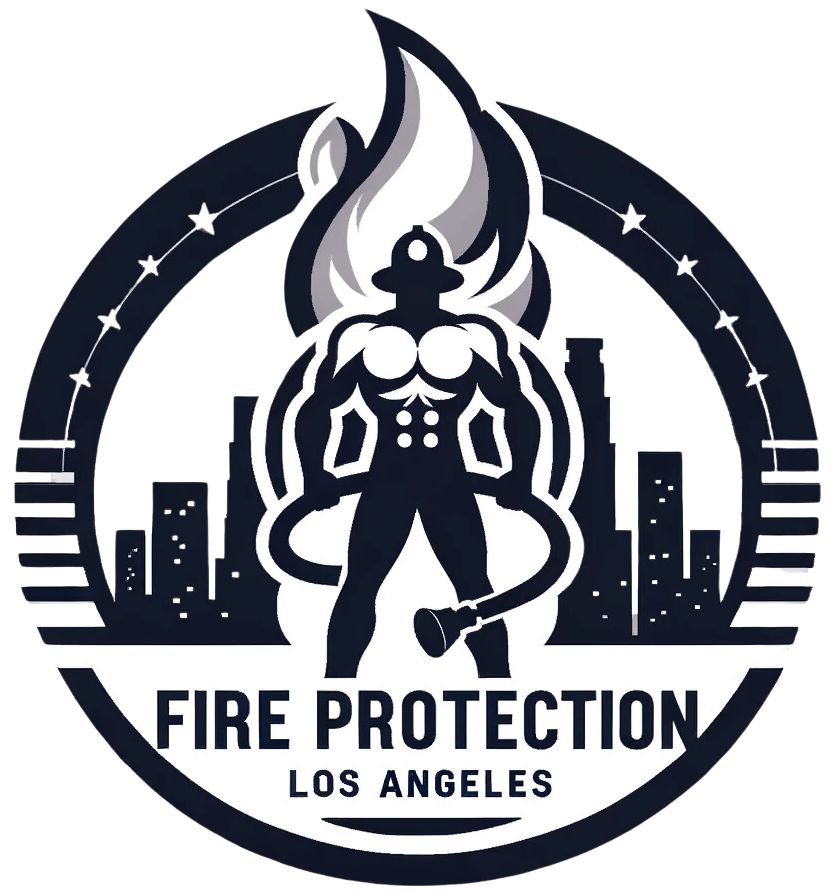We recognize that fireproofing is vital for protecting residential properties. By using fire-resistant materials like concrete, brick, and gypsum board, we enhance safety. Installing smoke detectors and fire extinguishers can greatly reduce risks during emergencies. Creating a fire escape plan and conducting drills helps guarantee everyone knows their exit routes. Regular maintenance of safety equipment, like testing smoke detectors, is critical. Additionally, implementing fire preventive measures, like keeping debris away from homes and choosing fire-resistant landscaping, adds another layer of protection. There's a lot more to explore about fireproofing that can help keep our homes safe.
Importance of Fireproofing

When it comes to protecting our homes, fireproofing is crucial. It greatly reduces the risk of property damage during fires, safeguarding both the structure and its contents. By implementing effective fireproofing measures, such as using fire-resistant materials, we can enhance the safety of everyone inside our homes, including emergency responders.
Fire resistance slows down the spread of flames, providing essential extra time for evacuation. Moreover, homes equipped with fire protection features often enjoy reduced insurance premiums. Insurers recognize that fireproofing lowers the risk of fire damage, making it a smart financial choice.
Compliance with local fire safety regulations is another important aspect of fireproofing. By adhering to these laws, we guarantee legal protection and the safety of everyone who enters our homes.
Additionally, proper fireproofing can increase a property's value and marketability. Potential buyers are more likely to be attracted to homes that prioritize safety features. In this way, investing in fire-resistant materials not only protects us but also enhances the overall appeal of our properties.
As we consider fireproofing, let's remember that it's not just about safety—it's an investment in our homes and our peace of mind.
Fire-Resistant Materials
Fire-resistant materials play an essential role in enhancing the safety of our homes. By choosing the right fireproofing materials, we can greatly reduce the risk of fire damage. For instance, concrete and brick are excellent options because they can withstand extremely high temperatures, with concrete enduring up to 1000°C for about 60 minutes. This durability helps maintain a building's structural integrity during a fire.
In addition to these materials, the use of fire-resistant design principles can greatly bolster fire safety in residential properties, as highlighted in fire-resistant design and safe surroundings vital for protection.
When it comes to roofing, we should consider Class A fire-rated materials, like slate and tile, which have a flame spread index of 0-25, making them the most effective at preventing fire spread. Additionally, insulation for fireproofing is vital. Materials such as fiberglass and mineral wool offer impressive fire resistance, with mineral wool able to withstand temperatures up to 1,220°C.
We can also treat combustible materials, like wood, with fire-retardant treatments to improve their resistance to ignition.
Fire Safety Equipment

In today's world, guaranteeing our homes are equipped with the right fire safety equipment is essential for protecting our families and properties.
First, we should install smoke detectors in every room. These alarms can reduce the risk of fire-related deaths by 55% in homes equipped with them.
Next, having accessible and regularly maintained fire extinguishers is imperative, as routine maintenance guarantees they function properly during emergencies. We should check them monthly and replace them every 5 to 12 years, depending on the type.
Sprinkler systems are another important addition to our fire safety equipment. Studies show that they can cut fire damage by up to 71% when installed in residential properties, appreciably slowing fire spread.
Additionally, we can't overlook carbon monoxide detectors; they alert us to dangerous gas levels that can be fatal if undetected.
Lastly, fire blankets provide an extra layer of protection, especially in kitchens where many domestic fires start.
Creating a Fire Escape Plan
Creating a fire escape plan is crucial for ensuring our safety during a fire emergency. First, we should establish multiple exit routes from each room, so everyone has a clear path to safety if a fire breaks out.
It's important to keep these escape routes clear of obstacles and clutter to facilitate a swift exit when every second counts. Additionally, we can enhance our plan by incorporating information on fire extinguisher inspection, ensuring that we're prepared to tackle small fires effectively if they arise.
Next, let's conduct regular fire drills to familiarize all household members with the escape plan. This practice helps improve our readiness in case of an actual fire, allowing us to react calmly and efficiently.
We also need to designate a meeting point outside the home where everyone can safely gather after evacuating, ensuring that we account for each person.
Maintenance and Inspection

To keep our homes fire-safe, we need to make maintenance and inspection a priority.
This means regularly checking smoke detectors, maintaining fire extinguishers, and scheduling professional inspections each year.
Regular Smoke Detector Checks
Smoke detectors are our first line of defense against fire hazards, making regular maintenance and inspection crucial. To guarantee these essential devices work effectively, we should test them monthly. This simple act assures they can alert us quickly in case of a fire.
Additionally, we need to replace the batteries at least once a year. Keeping fresh batteries in our smoke detectors helps maintain peak performance and safety.
Let's not forget that smoke detectors have a lifespan of about 10 years. After this period, we must replace them to comply with safety standards and guarantee reliability.
It's also important to regularly dust or vacuum our smoke detectors, as buildup can interfere with their sensors and affect performance, especially regarding heat transfer.
Some smoke detectors come with sealed lithium batteries, lasting up to 10 years without the need for replacements. However, once their service life is up, we need to replace the entire unit.
Fire Extinguisher Maintenance Schedule
Maintaining our fire extinguishers is just as important as regularly checking our smoke detectors.
These devices are our first line of defense against fires, and keeping them in great shape guarantees our fireproofing efforts are effective.
To do this, we should follow a clear maintenance schedule:
- Monthly Inspections: We need to check each fire extinguisher at least once a month. This includes confirming that the pressure gauge is in the green zone, indicating it's properly charged.
- Annual Professional Checkups: While we handle monthly checks, a professional maintenance check is essential at least once a year. They'll inspect for physical damage and recharge extinguishers as needed.
- Lifespan Awareness: Fire extinguishers typically last between 5 to 15 years. We must check the manufacturer's expiration date and replace any that are past their prime.
It's also important that these fire extinguishers remain accessible and clearly marked.
They shouldn't be blocked by furniture or other objects, guaranteeing we can grab them quickly in emergencies.
Annual Professional Inspections
Regularly scheduling annual professional fire safety inspections is essential for maintaining a safe residential environment. These inspections help us identify and mitigate potential fire hazards, ensuring our homes comply with local fire safety regulations.
During these visits, professionals test smoke detectors, confirming they're functioning properly. Remember, homes equipped with alarms can reduce fire death risk by 55%.
Inspectors also check fire extinguishers, ensuring they're fully operational and accessible in emergencies. It's important to be prepared. They examine our electrical systems too, looking for frayed wiring or overloaded circuits, which can become combustible at higher temperatures and lead to fires.
Additionally, maintaining our gutters and roofs free of debris is critical. This helps prevent fire spread from external sources, like embers during wildfires.
By adhering to annual professional inspections, we can greatly enhance our fire safety. It's not just about compliance; it's about protecting our loved ones and homes from potential disasters.
Understanding Fire Protection Methods
When it comes to fire protection methods, we can categorize them into two main types: active and passive systems.
Active fire protection includes tools like smoke detectors and sprinklers that respond directly to a fire, while passive features, such as fire-rated doors and non-combustible materials, work to slow down fire spread.
Active Fire Protection Systems
Active fire protection systems play an essential role in safeguarding our homes from potential disasters. These systems actively combat or respond to fires, greatly enhancing our safety.
By understanding the components of active fire protection, we can better protect ourselves and our loved ones. Here are three key elements we should consider:
- Smoke Detectors: These devices are vital, as they reduce the risk of fire-related deaths by 55% in homes equipped with alarms. Installing smoke detectors in every room can alert us quickly to danger.
- Sprinkler Systems: Automatically activating when they detect heat, these systems deliver water directly to the fire source. This quick response can dramatically reduce fire spread and damage, acting as our first line of defense.
- Fire Extinguishers: We need to keep these easily accessible and regularly maintained, especially in high-risk areas like kitchens and garages. Knowing how to use them can make a considerable difference in an emergency.
Passive Fire Protection Features
While active fire protection systems are crucial in responding to fire emergencies, passive fire protection features play an equally important role in preventing the spread of flames and smoke within our homes. These features include structural elements designed specifically to contain fires, such as fire-rated doors and walls.
For instance, fire doors are built to withstand flames for designated time periods, ensuring safe compartmentalization during a fire event. This compartmentalization can greatly enhance our safety.
Another critical component of passive fire protection is firestop systems. These systems seal gaps in walls and floors, effectively inhibiting the passage of smoke and flames. By using materials rated for fire resistance, such as fire-resistant coatings, we can improve the overall safety of our homes.
Class A materials, for example, indicate the highest level of fire safety performance.
Incorporating these passive fire protection features into our residential properties not only aids in fireproofing but also gives occupants additional time to evacuate during an emergency.
Fire Prevention Measures

Regularly implementing fire prevention measures is essential for safeguarding our homes from potential wildfires. By taking proactive steps, we can considerably reduce the risk of fire spreading to our properties.
Here are three key strategies we should focus on:
- Create a Fuel-Free Zone: We need to maintain a clear zone of at least 30 feet around our homes. This means regularly clearing dead vegetation and ensuring that shrubs and trees are spaced properly to prevent fire from reaching our structures.
- Trim Vegetation: Regularly trimming bushes and trees is vital. We should prune branches to a height of 8-10 feet. This minimizes the chance of fire spreading from vegetation to our homes, acting as a barrier against potential threats.
- Choose Fire-Resistant Plants: When landscaping, selecting fire-resistant plants and shrubs is a smart choice. These plants can help slow the spread of fire and provide an added layer of protection.
Interior Fire Safety
When it comes to interior fire safety, we can make smart choices that help protect our homes.
By selecting fire-resistant furnishings and installing smoke alarms in every room, we greatly lower the risk of fire spreading and increase our chances of staying safe.
These simple steps not only enhance our comfort but also provide essential safety measures for our families.
Fire-Resistant Furnishings Selection
In our quest for a safer home, selecting fire-resistant furnishings plays an essential role in enhancing interior fire safety.
By choosing the right materials, we can greatly reduce the risk of flames spreading within our living spaces.
Here are three key items to take into account:
- Fire-Resistant Curtains: Opt for curtains made from treated fabrics. These fire-retardant materials can help prevent flames from spreading, offering an extra layer of protection for everyone inside.
- Upholstery with Fire-Retardant Ratings: When purchasing sofas or chairs, look for upholstery that has been rated for fire resistance. This can greatly decrease the chance of ignition and slow down fire spread.
- Flame Retardant Paints and Sprays: Applying fire-retardant paints or sprays to our walls and furnishings can enhance their resistance to flames, giving us valuable time to escape in an emergency.
Smoke Alarm Installation
While selecting fire-resistant furnishings greatly contributes to our home's safety, the installation of smoke alarms takes our fire protection to the next level.
Smoke detectors should be installed in every room, including hallways and sleeping areas. This guarantees we receive maximum safety and early warning in case of fire. Statistics show that functioning alarms can reduce the risk of dying in a reported fire by 55%.
To enhance our fireproofing efforts, we should opt for interconnected smoke alarms. When one alarm sounds, they all do, providing a thorough alert throughout the home.
It's crucial to regularly test smoke alarms at least once a month to confirm they're working properly, and we must replace the batteries at least once a year.
We should also remember to replace smoke detectors every 10 years, as their sensors can degrade over time, reducing their effectiveness in detecting smoke and fire.
By taking these steps, we can greatly improve our home's safety and reduce heat hazards associated with fires.
Let's prioritize smoke alarm installation, guaranteeing that our homes are well-protected for everyone who lives in them.
Fire-Resistant Insulation Types

Understanding the different types of fire-resistant insulation is essential for enhancing the safety and energy efficiency of our homes. By choosing the right insulation, we can help protect our families from fire hazards.
Here are three common fire-resistant insulation types to contemplate:
- Fiberglass Insulation: Made of fine glass strands, this is the most common insulation type. It's noncombustible and offers R-values ranging from R-2.9 to R-3.8, providing effective thermal resistance, but it can only withstand temperatures up to 220°F.
- Mineral Wool Insulation: This includes glass wool, rock wool, and slag wool. It's noncombustible and can endure temperatures up to 1,220°F, with R-values between R-2.8 and R-3.5. Its superior heat resistance makes it a preferred choice for fire safety.
- Foam Insulation: Composed of cellulose and low-density plastics, foam options have flame retardant properties but are combustible at higher temperatures, typically resisting up to 300°F.
Most Fire-Resistant Building Materials
Choosing the right fire-resistant materials is just as important as selecting appropriate insulation for our homes.
When we think about fireproofing, we should consider materials that can withstand extreme temperatures. Concrete is one of the best options; it can endure temperatures up to 1000°C for about 60 minutes, making it an ideal choice for building structures.
While steel is strong, it starts to weaken at temperatures above 600°C and can melt completely at around 1400°C, so we often need to use protective measures like intumescent paint.
Gypsum board is another excellent material for fire-resistant interior finishes, thanks to its noncombustible core that contains water, slowing heat transfer during fires.
Brick also has impressive fire-resistant capabilities, enduring temperatures up to 1200°C, making it a reliable choice for walls and facades.
When it comes to insulation, we should look for fire-resistant options like mineral wool, which can withstand temperatures up to 1220°C.
Final Thoughts
In summary, prioritizing fireproofing protects our precious properties and keeps our families safe. By using fire-resistant materials, installing safety equipment, and planning escape routes, we can create a secure sanctuary. Regular maintenance and inspections guarantee our homes remain vigilant against hazards. Let's embrace effective fire prevention measures, and together, we'll build a better, brighter, and fire-safe future. Remember, safety isn't just a plan; it's a promise we make to ourselves and each other.








